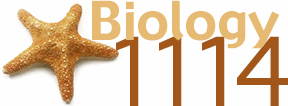
For a printable copy of this page click here.

Scenario: A scuba diver is collecting brownish-green algae for the Smithsonian. During her collection, she cuts her finger and is aghast to discover that her blood is brownish-green. Imagine her relief when she surfaces and realizes that her blood looks normally red, as is the algae she collected. We explore the origin of these color changes as a means of demonstrating the physical properties of light, light energy capture by organisms, and photosynthesis.
|
Icon
Key:
|
|
|
|
|
|
mimicry
warning coloration
camouflage
Examples of In-Class Discussion Questions:
Related Laboratory Experiments and Tutorials:

Lab 7. How
does the color of light influence the rate of photosynthesis?
Lab 8.
How do environmental or anatomical factors
effect the rate at which plants
remove water from the soil?
Corresponding Essential Study Partner Segments:
The Essential Study Partner is part of the McGraw-Hill Web Site.
To access it go here. Then follow these relevant paths below:Cells > Photosynthesis > Light and Pigments 



Cells > Photosynthesis > Chloroplast 


Cells > Photosynthesis > Light-dependent Reactions 




Cells > Photosynthesis > Light-independent Reactions 


Animals > Sense Organs > Light Receptors 


Many of these are figures and accompanying text, but some are video clips that should help you see the process in action.
The site for your textbook Life by Ricki Lewis
| Scuba diving links http://www.wgn.net/~fabio/gallery/mylinks.htm | |
| Red algae pictures The Tree of Life Web Project (ToL) is a collaborative effort of biolgists around the world. On more than 4000 World Wide Web pages, the project provides information about the diversity of organisms on Earth, their evolutionary history (phylogeny), and characteristics. | |
| The Tech Museum | Discover | Online Exhibits the online exhibit, Make a Spash With Color, provides an easy to understand description of the components of color, aspects of visible and non-visible light, the structure of the eye, and the process that occurs within the eye that enables us to see. | |
| The Human Eye and Single Photons describes how the human eye processes light | |
| Cell Biology provides descriptions, diagrams, and animated illustrations of how the phases and components of photosynthesis work | |
| Photosynthesis a thorough description of the factors and phases of photosynthesis | |
| PHOTOSYNTHESIS An in depth and easy to understand guide to photosynthesis including charts and pictures | |
| Chloroplast Diagram A diagram showing the components within a chloroplast | |
| Biology Center Includes information and diagrams pertaining to basic biology concepts such as cells, photosynthesis, mitosis, and DNA |
The website for your textbook has flashcards organised by chapters. You are only responsible for topics discussed in class. For this scenario, flashcards with the Major Terms Introduced can be found in:
Chapter 6: Photosynthesis